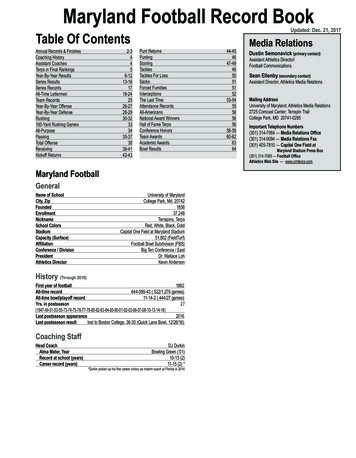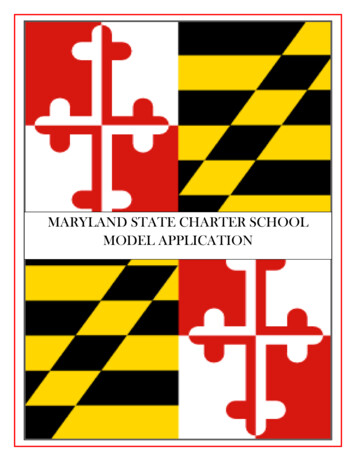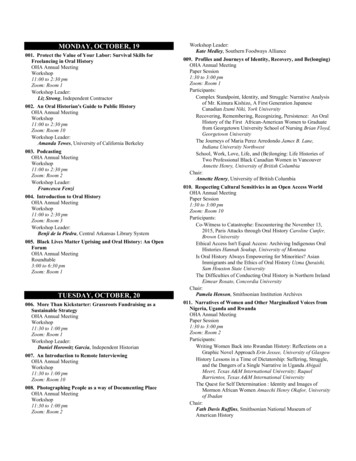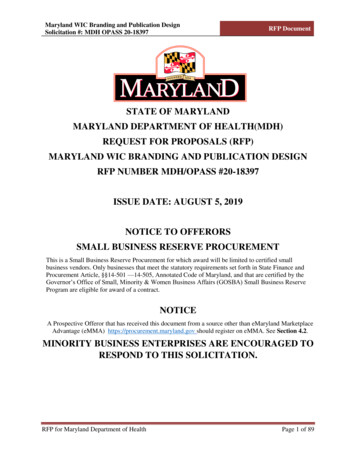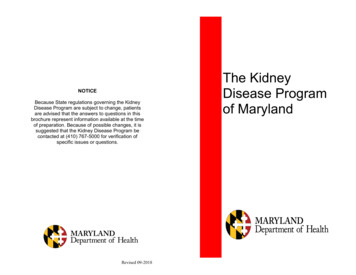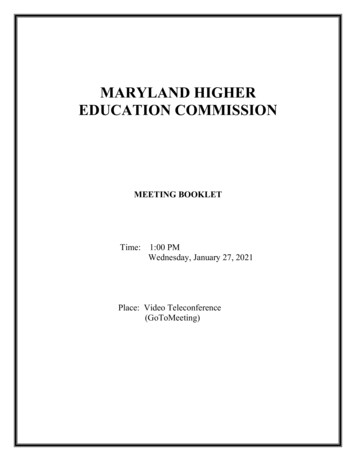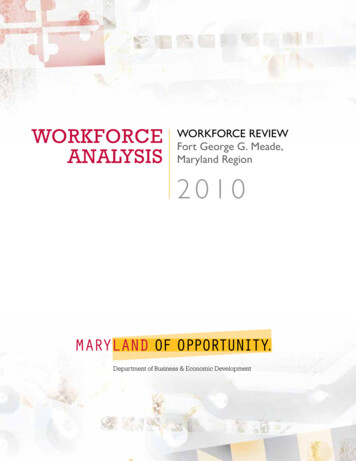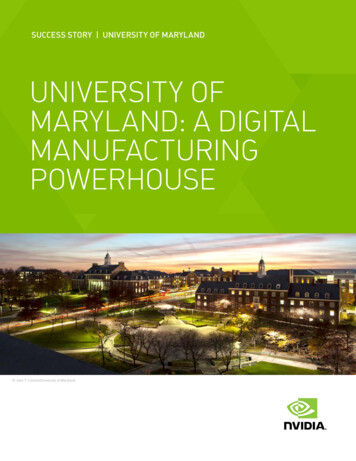
Transcription
SUCCESS STORY UNIVERSITY OF MARYLANDUNIVERSITY OFMARYLAND: A DIGITALMANUFACTURINGPOWERHOUSE John T. Consoli/University of Maryland
More access for more students - where andwhen they need it.THE UNIVERSITY’S ENGINEERING DEPARTMENT MERGESRESOURCES IN TERRAPIN WORKS AND VIRTUALIZES THEMFOR ALL.The University of Maryland’s A. James Clark School of Engineeringhas created a digital environment for students to create, design,analyze, manufacture, and iterate on ideas. This digital thread,from concept through to physical objects, is made possible byusing industry-leading software in combination with the latestdigital fabrication tools and advanced manufacturing techniques.Most of this complex software is available to any student on any John T. Consoli/University of Marylandmachine or device without the software being installed locallyREASONS FOR VIRTUAL GPU Enables access to all engineering appsto 38,000 students, no matter location ordevicethrough an application virtualization solution. This softwareincludes multiple different CAD/CAE/CAM solutions. Theapplication virtualization platform for these solutions is only madepossible with NVIDIA GPU technology. Allowed the Engineering school to growfrom 3,000 to 4,000 students with noadditional labs neededDigital fabrication is introduced to students starting in their Powers a combination of all digitalmanufacturing resources across multiplelocations around campusthem working in small teams to design and build an autonomous Enables breakthrough findings inbiomaterials, energy, and micromechanical research Propelling the University of Maryland tothe forefront of education and researchworldwidefreshman year through a hands-on, project-based class that hasover-the-sand vehicle. Throughout their studies, students haveaccess to a wide range of 3D printers that are able create objectsin everything from metal and polymer to cells in sizes from 150 nmto 1 meter. Digital design, analysis, and fabrication are skills thatevery engineer will need in the future; the University is preparingfuture engineers with those skills today.CUSTOMER PROFILEOrganizationUniversity ofMarylandSUCCESS STORY UNIVERSITY OF 56Size38,000studentsWebsitehttps://umd.edu/
John T. Consoli/University of MarylandPRODUCTSGraphics Acceleration:NVIDIA GRID vAppsMAKING PROCESSING-HEAVY APPSACCESSIBLE TO ALLHypervisor: Citrix XenApp/XenServer and VMwareThe University of Maryland (UMD) is the flagship campus of the state’sMonitoring: Citrix Director/Edgesite and SplunkLocated just outside Washington, D.C., it is a diverse community of 38,000GPU: NVIDIA Tesla M60 GPUthe pursuit of fearless ideas. As the nation’s first “Do Good” campus, thehigher educational system and a top-ranked public research institution.students, 9,000 faculty and staff, and 352,000 alumni, all dedicated toServer: Dell PowerEdge R730University is also strongly committed to social entrepreneurship.SUMMARYAN EARLY ADOPTER OF VIRTUALIZATION The University of Marylandis the flagship campus of thestate’s higher educationalsystem and a top-ranked publicresearch institution. The A. James Clark School ofEngineering has virtualized allstudent apps and establishedTerrapin Works, a world-classdigital manufacturing labaccessible virtually. Areas of research poweredby virtualized digitalmanufacturing includerobotics, tissue engineering,and energy research. More than 700 million worthof software and 100 3D printerspowered by NVIDIA GPUs andCitrix XenApp have created adigital infrastructure to driveideas through to productsSUCCESS STORY UNIVERSITY OF MARYLANDUMD’s A. James Clark School of Engineering offers unique access tofederal laboratories and groundbreaking industries due to its proximityto the D.C. area. In 2013, it was the recipient of the largest-ever softwaregrant from Siemens, an in-kind grant with a commercial value of morethan 750 million. Those funds have propelled UMD’s Engineeringdepartment to be one of the most innovative in the country. And at theheart of it all is the NVIDIA virtualization product, NVIDIA GRID virtualApplications software (GRID vApps).A decade ago, the team at UMD, led by Jim Zahniser, wanted to make itsprocessing-heavy apps more accessible to all students, even ones not inthe engineering department. “We had a basic computer lab and still do,”said Zahniser. “But the CAD apps especially made it difficult to virtualizewithout NVIDIA virtual GPU software.”
“The real power ofvirtualization is inaccess—making sureevery member of theUMD community hasthe opportunity towork at the very edgeof science, technology,and research. Thatsimply wouldn’t bepossible withoutNVIDIA Tesla GPUsand GRID vApps.”Jim ZahniserExecutive Director,EngineeringInformation TechnologyUniversity of MarylandSOLUTIONThe department was an early adopter of the NVIDIA GRID K2, which madea huge difference in running high-end CAD apps. It and has now moved toDell R730 servers with NVIDIA Tesla M60 GPUs and the latest GRID vAppssoftware, enabling even more power and speed. Said Zahniser, “We’remigrating all our apps onto servers running NVIDIA graphics acceleratorsand GRID vApps. Everything simply runs better with NVIDIA GPUs.”The engineering school has gone from 3,000 to 4,000 undergrads in ashort amount of time with no additional labs needed, thanks to NVIDIATesla GPUs and GRID vApps software. And they’re not stingy—any ofUMD’s 38,000 students can access the virtualized environment, notjust engineering.All of this is a boon to the University and places its engineering departmentamong the best in the country. But the aforementioned Siemens grant hasenabled UMD to take virtualization to the cutting-edge with the creation ofTerrapin Works, a world-class digital manufacturing lab that is accessibleto the campus and surrounding community virtually.3D PRINTING FROM ANY MACHINEPulling together all the digital fabrication resources in Engineering,Terrapin Works offers production and design services, as well as accessto equipment across a multitude of locations, thanks to virtualizationpowered by NVIDIA GRID vApps.Said Zahniser: “We have 700 million worth of software running onNVIDIA virtual GPUs enabled by NVIDIA GRID vApps that allow the printingof metal, plastics, and cells across 100 3D printers. Researchers areenhancing their work with 3D printing, including in tissue engineering, biomaterials, and micro-mechanical devices.”The department charges a fee for service, allowing people to buy time onthe machines. “3D printers are expensive, especially the larger ones,”added Zahniser. “Paying a small fee to take advantage of our state-of-theart hardware and software makes much more sense for most people thaninvesting in a big machine.”SUCCESS STORY UNIVERSITY OF MARYLAND
Labs powered by Terrapin Works include: MakerBot Innovation Center, where students and faculty get to knowthe basics of digital manufacturing with over 60 3D printers Rapid Prototyping Center, the main hub of Terrapin Works, with higherend machines and electronics prototyping Research Prototyping Lab, home to the highest-end machines, capableof extremely high detail and durability John T. Consoli/University of Maryland Keystone Labs, for the exclusive use of first-year engineering students Terps Racing, home to subtractive CNC machines and where studentscollaborate to build race cars and compete in national competitions“We’re migrating allour virtual apps ontoservers runningNVIDIA GPUs and GRIDsoftware. Everythingsimply runs betterwith GPUs.”Jim ZahniserExecutive Director,EngineeringInformation TechnologyUniversity of Maryland Tissue Engineering and Biomaterials Lab, which focuses on the studyof biomaterials for the delivery of therapeutics, scaffolds for orthopedictissue engineering applications, and the interaction of biomaterials andtissues University of Maryland Energy Research Center, studying the mostefficient use of natural resources while minimizing environmentalimpacts and our dependence on imported energyCollectively, the resources available from Terrapin Works—and the workit enables—are propelling the University of Maryland to the forefront ofeducation and research worldwide. Concluded Zahniser, “The real powerof virtualization powered by NVIDIA GRID vApps is in access—making sureevery member of the UMD community has the opportunity to work at the veryedge of science, technology, and research. That simply wouldn’t be possiblewithout NVIDIA’s virtual GPU products.”To learn more about NVIDIA virtual GPU solutions visit:www.nvidia.com/virtualgpuwww.nvidia.com 2017 NVIDIA Corporation. All rights reserved. NVIDIA, the NVIDIA logo, and NVIDIA GRID aretrademarks and/or registered trademarks of NVIDIA Corporation. All company and product names aretrademarks or registered trademarks of the respective owners with which they are associated. Dec17
CUSTOMER PROFILE Organization University of Maryland Industry Education Location Maryland Founded 1856 Size 38,000 students Website https://umd.edu/ More access for more students - where and when they need it. The University of Maryland's A. James Clark School of Engineering has created a digital environment for students to create, design,

